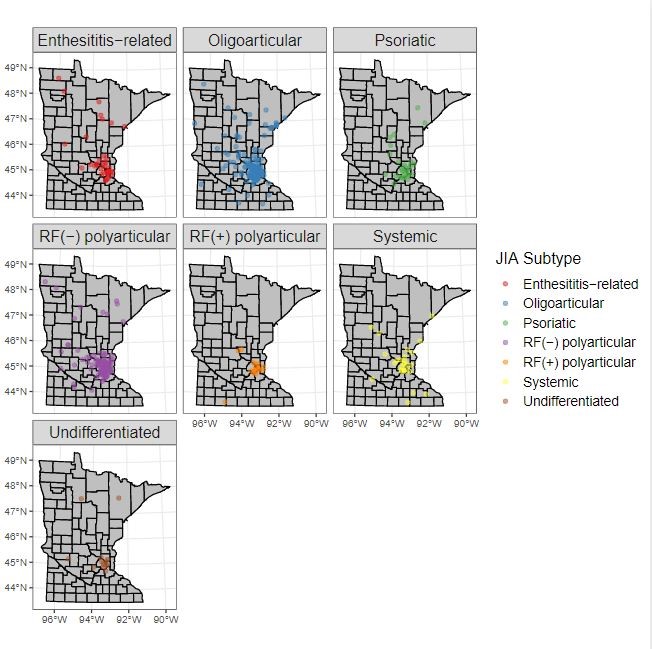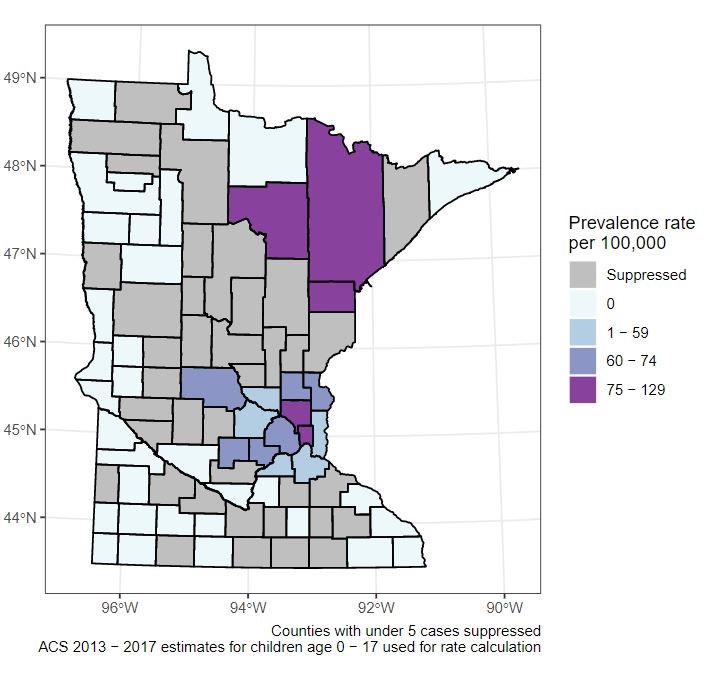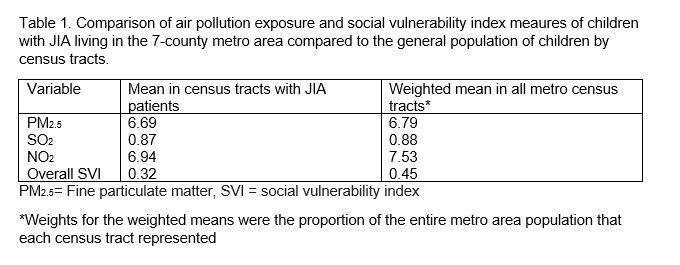Session Information
Session Type: Poster Session B
Session Time: 5:00PM-6:00PM
Background/Purpose: It is widely accepted that juvenile idiopathic arthritis (JIA) is caused by a combination of genetic and environmental factors, but the potential environmental triggers are not well-known. Some studies have shown air pollution as a possible risk factor for JIA and rheumatoid arthritis. We mapped children with JIA living in Minnesota and used publicly available geospatial data to assess whether air pollution exposure and/or community social vulnerability were associated with JIA.
Methods: We geocoded 4 years of patients enrolled in the Juvenile Arthritis in Minnesota (JAMinn) study who had a current address and calculated county-level prevalence rates of JIA throughout the state. Enrollment criteria for JAMinn are age < 16, JIA diagnosis by treating rheumatologist, and Minnesota residence at the time of enrollment. The vast majority of patients were enrolled at the University of Minnesota (UMN). We also studied markers of air pollution as factors associated with JIA. To avoid biases due to referral patterns, we limited air pollution exposures to children who lived within the 7-county metro area of Minneapolis and Saint Paul, MN, which is where the UMN clinic is located. We used census tract-level data and compared weighted averages of modeled annual air pollution concentrations including fine particulate matter 2.5 (PM2.5), sulfur dioxide (SO2), and nitrogen dioxide (NO2), and the Centers for Disease Control and Preventions social vulnerability index (SVI) in children with JIA compared to the general population of children in the metro area.
Results: 389 patients with JIA were included in the geospatial mapping throughout the state of Minnesota by JIA subtype (Figure 1). Prevalence was mapped at the county level (Figure 2). The prevalence of JIA in Hennepin County, the most populated county in Minnesota, ranged from 60-74 per 100,000 children. Five counties had relatively higher prevalence rates (75-129) per 100,000 children. Forty-five percent (175/389) of patients with JIA lived in the metro area and were included in the air pollution and SVI comparison (Table 1). There were 230 census tracts with children with JIA out of the 740 census tracts in the metro area. Patients with JIA appeared to have lower air pollution exposures and were less socially vulnerable compared to the general population.
Conclusion: To our knowledge, this is the first study in the US to use geospatial data to assess environmental risk factors for all subtypes of JIA. Prevalence rates varied by county, but this may be secondary to small case counts and variations in population sizes by county; further investigation is needed. The study found that patients with JIA living in the metro area were exposed to relatively lower concentrations of PM2.5 and NO2 and lived in census tracts that were relatively less socially vulnerable compared to the metro area as a whole. This was a small preliminary study and our air pollution assessments were not adjusted for demographic data such as race, JIA subtype, or patient age, and we lacked access to healthy controls. Larger national studies that include demographic and clinical data, and that use more refined geospatial techniques are needed to better study these environmental risk factors.
 Figure 1. Geospatial distribution of children with JIA living in Minnesota by JIA subtype
Figure 1. Geospatial distribution of children with JIA living in Minnesota by JIA subtype
 Figure 2. Prevalence rates of JIA by population of children living in Minnesota, by county.
Figure 2. Prevalence rates of JIA by population of children living in Minnesota, by county.
 Comparison of air pollution exposure and social vulnerability index measures of children with JIA living in the 7-county metro area compared to the general population of children by census tracts.
Comparison of air pollution exposure and social vulnerability index measures of children with JIA living in the 7-county metro area compared to the general population of children by census tracts.
To cite this abstract in AMA style:
Correll C, Rau A, Berman J. Juvenile Arthritis in Minnesota: Geospatial Variability and Environmental Exposures in Juvenile Idiopathic Arthritis [abstract]. Arthritis Rheumatol. 2023; 75 (suppl 4). https://acrabstracts.org/abstract/juvenile-arthritis-in-minnesota-geospatial-variability-and-environmental-exposures-in-juvenile-idiopathic-arthritis/. Accessed .« Back to 2023 Pediatric Rheumatology Symposium
ACR Meeting Abstracts - https://acrabstracts.org/abstract/juvenile-arthritis-in-minnesota-geospatial-variability-and-environmental-exposures-in-juvenile-idiopathic-arthritis/
